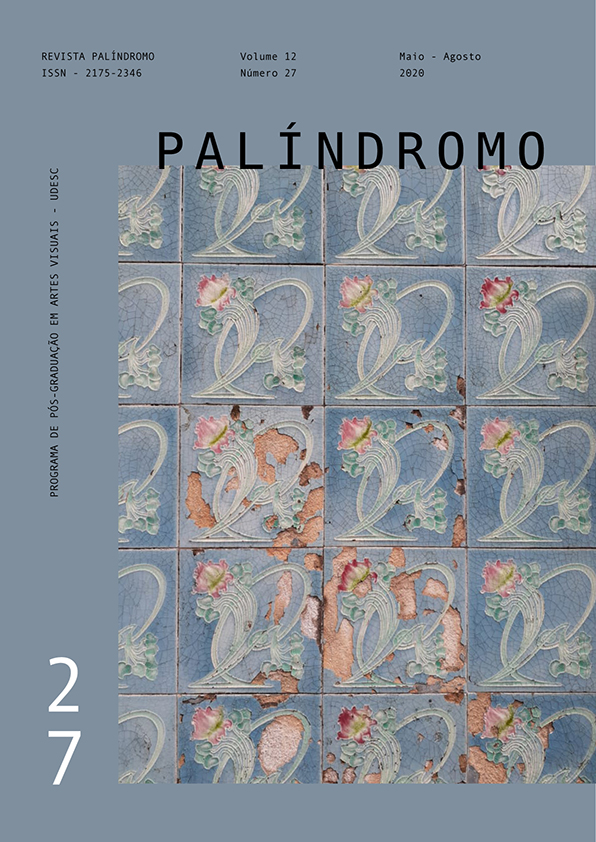The Ornament in John Ruskin's thought
DOI:
https://doi.org/10.5965/2175234612272020120Keywords:
John Ruskin, Architecture, Ornament, ImperfectionAbstract
This paper aims to show and perceive the presence of the living ornament in the formation of John Ruskin's aesthetic thought. His reflections on the expressive work in architecture, manifested above all in its ornamentation, will be taken under the concept of the fantastic paradox of imperfection, which highlights the vitality and pleasure of the worker in his workshop practice. This manifestation of life and happiness could only be achieved by the communion between the manual and intellectual work of its artisans.
Downloads
References
AMARAL, Claudio. John Ruskin e a Natureza do Gótico. Arquitextos, nº 235, ano 20, 2019.
CLARK, Kenneth. The Gothic Revival: an Essay in the History of Taste. London: Constable, 1950.
CLARK, Kenneth. Ruskin Today. Baltimore: Penguin Books, 1967.
FRAMPTON, Kenneth. História crítica da arquitetura moderna. Tradução de Jefferson Luiz Camargo e Marcelo Brandão Cipolla. São Paulo: Martins Fontes, 2015.
LANDOW, George. Aesthetic and Critical Theory of John Ruskin. Princeton: Princeton University Press, 1971.
LIRA, José Tavares Correia. Ruskin e o trabalho da arquitetura. Risco: Revista de Pesquisa em Arquitetura e Urbanismo, Universidade de São Paulo, São Paulo, v. 4, n. 2, p. 77-86, 2006.
RUSKIN, John. A economia política da arte. Tradução: Rafael Cardoso. Rio de Janeiro: Record, 2004.
RUSKIN, John. As pedras de Veneza. Tradução: Luís Eduardo de Lima Brandão. São Paulo: Martins Fontes, 1992.
RUSKIN, John. The Seven Lamps of Architecture. London: Library Edition, works, v. viii, 1903. Disponível em: https://bit.ly/2nVdW45.
RUSKIN, John. The Stones of Venice. London: Library Edition, v. I, works, v. ix, 1903 Disponível em: https://bit.ly/2nVdW45.
RUSKIN, John. The Stones of Venice. London: Library Edition, v. II, works, v. x, 1904 Disponível em: https://bit.ly/2nVdW45.
RUSKIN, John. The Stones of Venice. London: Library Edition, v. III, works, v. xi, 1904 Disponível em: https://bit.ly/2nVdW45.
RUSKIN, John. Two Lectures on the Political Economy of Art (1857-1880). In: RUSKIN, John. A Joy for ever. London: Library Edition, part I, works, v. xvi, 1905, p. 15-174. Disponível em: https://bit.ly/2nVdW45.
RUSKIN, John. Lectures on Architecture and Painting. Adenda aos capítulos I e II. London: Library Edition, part I, works, v. xii, 1904, p. 81-101. Disponível em: https://bit.ly/2nVdW45.
RUSKIN, John. Modern Manufacture and Design (1859). In: RUSKIN, John. The Two Paths. London: Library Edition, lecture III, works, v. xvi, 1905, p. 319-345. Disponível em: https://bit.ly/2nVdW45.
RUSKIN, John. Influence of Imagination in Architecture (1857). In: RUSKIN, John. The Two Paths. London: Library Edition, lecture IV, works, v. xvi, 1905, p. 346 -374. Disponível em: https://bit.ly/2nVdW45.
RUSKIN, John. Unto this Last (1860). London: Library Edition, part I, works, v. xvii, 1905, p. 5-118. Disponível em: https://bit.ly/2nVdW45.
TOWNSEND, Francis G. Ruskin and the Landscape Feeling: a critical analysis of his thought during the crucial years of his life, 1843-56. Urbana: University of Illinois, 1951.
Downloads
Published
How to Cite
Issue
Section
License
Copyright (c) 2020 Eliane Baader de Lima

This work is licensed under a Creative Commons Attribution 4.0 International License.
COPYRIGHT STATEMENT
The articles published by the magazine are free to use, intended for academic and non-commercial applications. Copyright is all assigned to the magazine. The articles whose authors are identified represent the expression from the point of view of their authors and not the official position of Palíndromo Magazine. The author (s) commits to whenever they publish material referring to the article published in Palíndromo mention this publication as follows:
This article was originally published by Palíndromo magazine in its volume (place the volume), number (place the number) in the year of (place the year) and can be accessed at: http://www.revistas.udesc.br/index.php/palindromo


